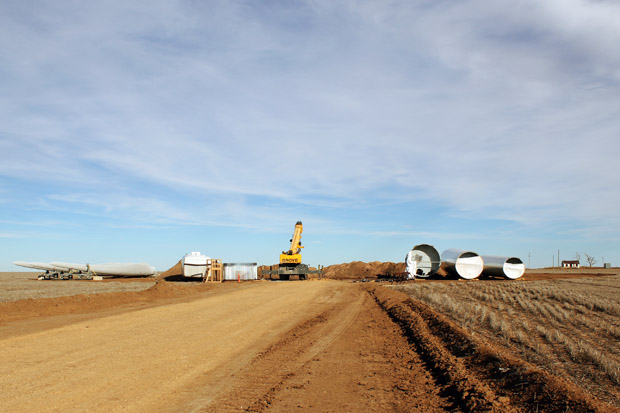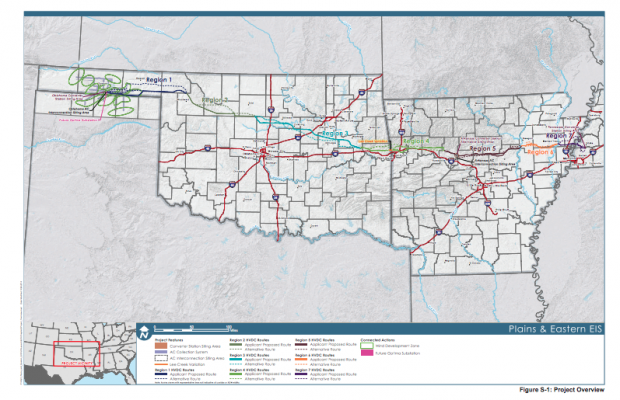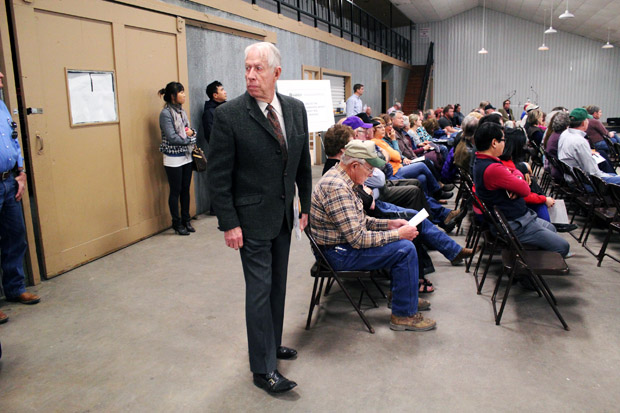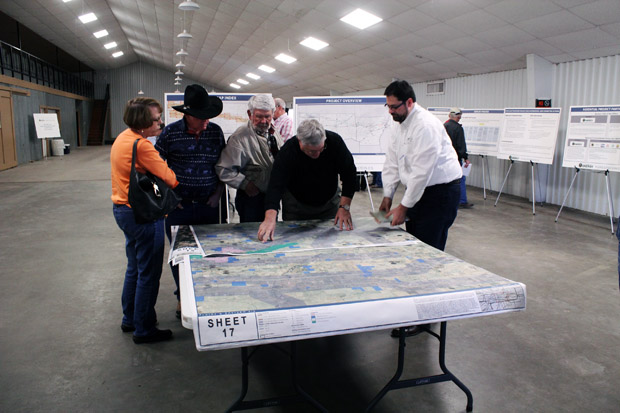
A wind farm under construction near Balko, Okla.
Joe Wertz / StateImpact Oklahoma


A wind farm under construction near Balko, Okla.
Joe Wertz / StateImpact Oklahoma

Joe Wertz / StateImpact Oklahoma
A wind turbine under assembly near Balko in Oklahoma's Panhandle. When completed, the turbine will be part of D.E. Shaw Renewable Investments' 300-megawatt Balko Wind Project.
The wind energy boom has largely evaded Oklahoma’s Panhandle, but new turbine projects and a proposal for a $2 billion transmission line could transform the prairie into a national wind energy hub.
But the projects are being planned amid uncertainty at the state Capitol, where tax credits for the wind industry are in the crosshairs.
Despite being one of the state’s richest sources of wind energy, the Oklahoma Panhandle is home to very few wind farms.
Carroll Beaman knows why. The fourth-generation farmer was born during the height of the Dust Bowl and still owns the homestead his family settled shortly after the turn of the century.
“It’s very sparsely settled,” he says. “No industry, except for some of the oil and gas, so it’s never had transmission.”
Transmission is the large-scale, bulk distribution of electricity from power generator to power user. The lack of ability to provide transmission — often referred to as the “transmission gap” — is a big reason only two of the state’s 33 wind farms are in the Panhandle.
Still, the wind energy potential in Oklahoma’s Panhandle is so good, developers are betting big. Beaman is an oilman in his 80s who worked at Exxon for 19 years. These days, he’s brokering deals for large swaths of land that could host future wind farms.
“We have now over 175,000 acres leased,” he says. “Transmission is the key thing.”
Beaman wants to attract new wind developers, and he’s hoping a new high-voltage line will help fill the transmission gap.

Clean Line Energy Partners
An overview of the proposed route for the Plains and Eastern Clean Line Project.
At a public meeting in late January hosted inside a red, barn-like events center in Guymon, interested — and concerned — landowners asked questions and looked at maps showing possible routes for the Plains and Eastern Clean Line.
The transmission line would carry high-voltage direct current instead of alternating current, the type most power lines are designed to distribute. The HVDC line would act like a wind power superhighway that, if built, would ferry electricity from turbines in the Panhandle 700 miles east to the Memphis, Tenn., area, where it would connect to the power grid in the southeastern United States.
If approved and built, the 600-kilovolt Plains and Eastern Clean Line could transport 3,500 megawatts of wind power.
Clean Line Energy Partners, the Houston-based company that wants to build the line, has public utility status in Oklahoma, but the project still needs approval from the federal government.
The project faces opposition in Oklahoma and along the route in Arkansas, particularly over the possibility that the company might use eminent domain to secure land. But proponents in Oklahoma are also worried about roadblocks at the Capitol — not for the power line, but for the wind industry that would feed it.

Joe Wertz / StateImpact Oklahoma
Carroll Beaman, an oilman and former Exxon employee, is now brokering large swaths of the Oklahoma Panhandle for future wind projects.
State lawmakers have filed more than a dozen bills addressing Oklahoma’s wind industry for the 2015 legislative session.
Oklahoma state Sen. Mike Mazzei, R-Tulsa, has proposed legislation that would reel in tax credits used by the wind industry. Mazzei, who also chairs the state Senate Finance Committee, says data gathered over the summer during an interim study show that while incentives cost the state $60 million in 2015, landowners with wind leases received only $9 million from wind companies.
Mazzei says taxpayers are “not getting a great return on their investment.”
“Actually, a pretty terrible return,” he says.
Oklahoma lawmakers start the 2015 legislative session with a $300 million budget hole that could grow larger if low oil prices continue to drag down tax revenues. Curtailing tax credits and economic incentives — for wind and other industries — has been identified by Gov. Mary Fallin, lawmakers and state finance officials as one way to squeeze more money for appropriations.
“We certainly can’t afford these giveaways of taxpayer money anymore,” Mazzei says.

Joe Wertz / StateImpact Oklahoma
Panhandle residents pouring over maps showing possible routes for the Plains and Eastern Clean Line Project, which, if approved, would funnel wind power from Oklahoma to the southeastern U.S. power grid.
Vicki Ayres-Portman, director of the Panhandle Regional Economic Development Coalition, is eager for Guymon to become a wind hub and attract new jobs and investment, but she worries that Oklahoma landowners could miss out on lucrative wind leases if incentives are trimmed too much.
“Oklahoma, unfortunately, has been kind of a yo-yo, really ever since wind energy tax credits came on,” she says.
For its part, the wind industry says Oklahoma’s incentives are working and have attracted turbine projects that otherwise would have been built in Nebraska or Kansas. The industry also has been fueled by a federal Production Tax Credit that expired at the end of 2014, which has increased the role state-level incentives have in influencing wind companies when they are siting turbine projects, Ayers-Portman says.
“The whole Panhandle is only 30 miles across,” she says.
Even if the wind power superhighway does get approved and is built in Oklahoma, Ayers-Portman says the traffic — the electricity from turbines — could start on either side of the border.
“If Oklahoma does away with the tax credits and Kansas and Texas still has a lucrative tax credit package or incentive package, then Oklahoma is going to miss the boat.”
Mazzei, the Republican lawmaker from Tulsa, says that won’t happen. He thinks Oklahoma’s wind energy tax credits and incentives are too generous, but he says lawmakers will work to make sure they’re competitive with Kansas and Texas.